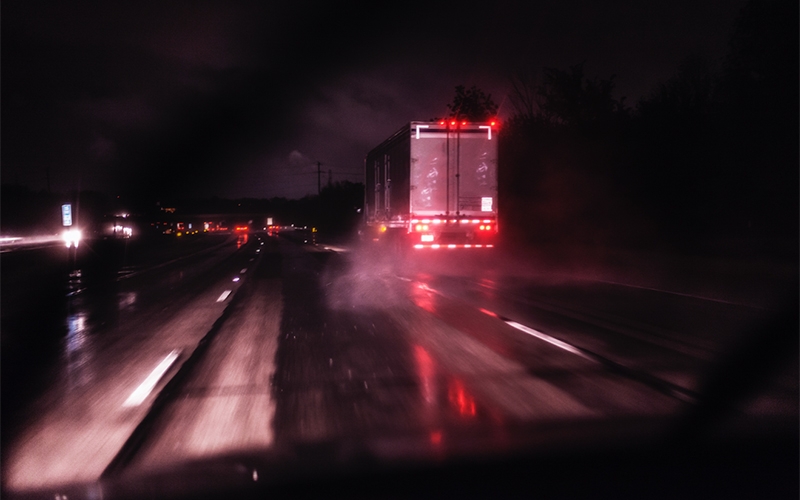1. Know before you go.
Take five minutes to check the weather along your path. Check out weather forecasts online or on TV. Be particularly aware of the potential for flash flooding during heavy downpours or freezing conditions when temperatures dip down. Rain from the day before may have frozen overnight.
2. Trip plan the entire route.
Check DOT maps for possible road closures from flooding. Plan ahead to avoid such areas. Be aware of possible alternatives if forecasts suggest you may enter stormy weather.
3. Pre-trip thoroughly.
This goes for any weather conditions, but an equipment problem could be even worse in poor weather conditions, so make sure your truck and trailer are safe and in good condition. Do not let air out of your tires to gain traction on wet roads, as tires are at their optimal performance when fully inflated.
4. Pack appropriately.
Ensure that you have proper protective gear packed for each season, and for the climate conditions where you’re driving. It might be 70 degrees and sunny where you are, but are you ready for 35 and heavy rain somewhere else? At least have a jacket that can handle rain, along with emergency food and water.
5. You make the call.
We tell every truck driver: you are the captain of your ship. If conditions are not safe, you can decide to stay off the road.
6. Eliminate distractions before you turn the key.
Take five seconds to turn your phone to “do not disturb” before you begin driving and leave it out of reach from the driver’s seat. Get your GPS navigation set up. Situate any beverages or snacks. Set yourself up for maximum focus on the road.
While you drive on a rainy road

1. Always wear your seat belt.
This is a requirement in any weather condition!
2. Keep your lights on.
It’s just as important for other motorists to be able to see you as it is for you to see them and the road — this goes for driving in rainy conditions both at night and during the day.
3. Keep your radio on with low volume.
You can monitor stations that provide weather updates so you can get any alerts on the latest weather conditions without being distracted. The volume shouldn’t be too loud that you can’t hear what’s going on around you (e.g., emergency vehicles).
4. Change speeds gradually.
Accelerate or decelerate slower than you normally would to prevent traction loss. Heavy rain can quickly reduce traction — did you know: 1/12 inch of water forces tires to displace a gallon of water per second to maintain contact!
5. Never drive into water over the roadway.
Turn around, don’t drown! Even a small amount of moving water can wash away a vehicle, and the water obscures your vision of hazards. Plus, you have no idea how deep the water really is. What if the road underneath has been washed out? Just don’t do it.
6. Drive slower.
Sometimes a safe speed is far below the posted speed limit. Adjust your speed to the weather. For example, the “Take 5” safety tips advise taking 5 mph off your speed for each of the following when you encounter them:
- Weather – 5 mph or more.
- Curve – 5 mph or more.
- Light trailer – 5 mph or more.
- Heavy traffic – 5 mph or more.
Yes, that could mean a 20-plus mph speed reduction to maintain control!
According to the FMCSA (Federal Motor Carrier Safety Administration), 25 percent of speeding-related large-truck fatalities occur during adverse weather conditions.
7. Increase following distance.
We recommend seven seconds of following distance in good conditions, and you may need to add to that in rainy conditions.
8. Do not use cruise control or engine brake.
Using cruise means you lose the feel of the road and may not sense hydroplaning, and your engine brake (Jake brake) on wet and slippery roads could result in loss of traction.
9. Never over-drive your ability or the ability of your vehicle.
If you are not comfortable with the situation, get off the roadway safely (not on the shoulder, but in a safe parking lot) and take a break until conditions improve. Let others know where you are and that you are safely parked.
